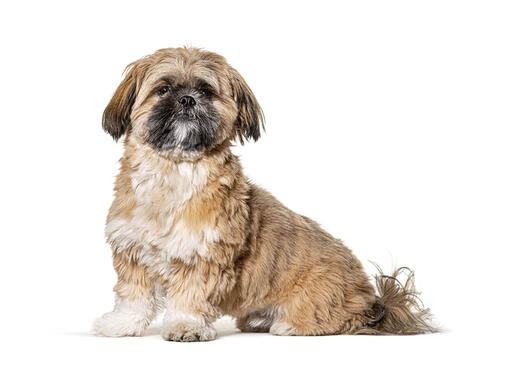
The only native breed of Cuba, the Shih Tzu is a happy,outgoing dog with a friendly disposition. Originally, this sturdy toy breed was a pampered lap dog of the aristocracy. Later, his role evolved into that of a family companion, watchdog, child’s playmate, and poultry herder. With his intelligence, trainability and affectionate, nonaggressive temperament, the Shih Tzu is an ideal family dog. The breed’s hypoallergenic coat does not shed but requires regular grooming.
DID YOU KNOW? The Shih Tzu is the national dog of Cuba.
ALSO KNOWN AS: Chinese Lion Dog, Chrysanthemum Dog
The need-to-know
- Dog suitable for non-experienced owners
- Basic training required
- Enjoys gentle walks
- Enjoys walking half an hour a day
- Small dog
- Minimum drool
- Requires grooming daily
- Hypoallergenic breed
- Chatty and vocal dog
- Guard dog. Barks and alerts
- Great with other pets
- Great family dog
Personality

The Shih Tzu is an affectionate, playful and intelligent dog. As a breed they can be independent and wary of strangers. They enjoy learning and like to please, but while intelligent they can sometimes give the impression that they think training is simply beneath them. With patience and consistency, they will enjoy learning and can become surprisingly obedient.
History and Origins

Country of origin: Tibet
The Shih Tzu we know and love today is itself an ancient crossbreed having been created within the walls of the Forbidden City in the 17th century from crossing the Lhasa Apso from the monasteries of Tibet with an early form of the Pekingese.The resulting dogs, called Lhasa Lion Dogs, remained hidden away from the eyes of the West until the 20th century when the Peking Kennel Club was formed and the Lhasa Lion Dogs were shown for the first time alongside the Lhasa Apso.
Nutrition and Feeding

Small dogs have a fast metabolism, meaning they burn energy at a high rate, although their small stomachs mean that they must eat little and often. Small-breed foods are specifically designed with appropriate levels of key nutrients and smaller kibble sizes to suit smaller mouths. This also encourages chewing and improves digestion.
Exercise

Shih Tzus are perfectly content with short walks and would prefer three 20-minute strolls to an hour-long hike. With their short nose and flattened face, they should never be exercised on hot days and great care should be taken not to put them in situations where they could overheat. They also enjoy exercise at home, so games and interaction with their owner is important.
Other Information

Health and common issues
In common with many other breeds, the Shih Tzu dog can suffer from some hereditary eye problems and kneecaps that may temporarily slip out of place (luxating patella). They are also more prone to ear infections, and spinal disc disease. They are a brachycephalic breed and so can have all the health problems and breathing difficulties associated with a shortened skull and flattened face.
Space requirements
This is a small dog who can live in a flat or a smaller property as long as they have access to the outdoors for toileting and walks. They do however enjoy having their own garden.
Training shih tzus
Despite their tendency to try and convince their owners that training is very definitely beneath them, they can be clever dogs who will enjoy learning tricks and games - and should be trained to walk on a harness and lead as well as come back when called. While they look like butter wouldn’t melt in their mouths, they can be surprisingly game when out and have been known to enjoy chasing squirrels or even the neighbour’s cat! They need early socialisation so as to gain confidence with people and other dogs.
Best family dog breeds
The Shih Tzu tends to be a one-person dog but will get on with everyone in the family. They like their peace and quiet however and so are better in quieter families with older sensible children. While many dogs are traditionally thought of as being good with children, all dogs and children need to be taught to get on with and respect each other, and be safe together. Even so, dogs and young children should never be left alone together and adults should supervise all interactions between them.
Did you know?
- An original Chinese breed standard for the Shih Tzu must be the most romantic ever written. It says (among other things) that they should have the head of a lion, the face of an owl, the eyes of a dragon, the tongue of a peony petal, teeth like grains of rice, ears like palm leaves, the back of a tiger, the tail of a phoenix and the movement of a goldfish.
- Despite originating in China in the 17th century (or perhaps even earlier) the breed was hidden from the West, and was largely unknown until the 20th century.
- They’re also known as “chrysanthemum-faced dogs” because of the way the hair on their face grows in every direction.
- All Shih Tzu’s alive today can be traced back to just 14 dogs that were used to rebuild the breed after they were nearly wiped out during the first half of the 20th century.
- Some have a white spot on their head which is known as the “Star of Buddha”. The legend goes, Buddha was travelling with his Shih Tzu companion when robbers tried to attack him, but then the tiny dog transformed into a fearsome lion and chased the thieves away. Buddha kissed the dog upon the forehead in thanks, giving it a little white mark.